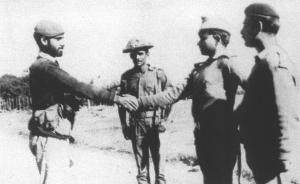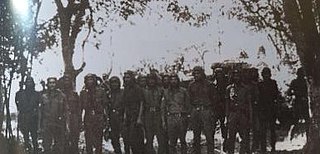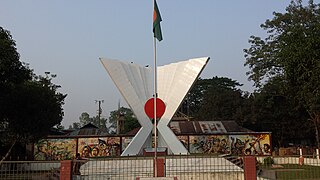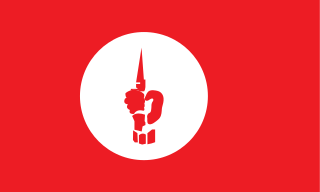
Jamalpur is a district in Bangladesh, part of the Mymensingh Division. It was established in 1978.

Field Marshal Sam Hormusji Framji Jamshedji Manekshaw, also known as Sam Bahadur, was the chief of the army staff of the Indian Army during the Indo-Pakistani War of 1971, and the first Indian Army officer to be promoted to the rank of field marshal. His active military career spanned four decades, beginning with service in World War II.

Operation Searchlight was a military operation carried out by the Pakistan Army in an effort to curb the Bengali nationalist movement in former East Pakistan in March 1971. Pakistan retrospectively justified the operation on the basis of anti-Bihari violence carried out en masse by the Bengalis earlier that month. Ordered by the central government in West Pakistan, the original plans envisioned taking control of all of East Pakistan's major cities on 26 March, and then eliminating all Bengali opposition, whether political or military, within the following month.

The First and SecondBattles of Hilli were two major battles fought during the Bangladesh Liberation War on 22–24 November and 10–11 December 1971. They are generally regarded as the bloodiest battles of the eastern front of the Indo-Pakistani War of 1971. The first battle saw, according to veterans of the battle, the fiercest fighting of the war, but the second was much tamer.
Muhammad Ataul Gani Osmani, was a Bengali military leader. Osmani's career spanned five decades, beginning with service in the British Indian Army in 1939. He fought in the Burma Campaign during World War II. After the partition of India in 1947, he joined the Pakistan Army and served in the East Bengal Regiment, retiring as a colonel in 1967. Osmani joined the Provisional Government of Bangladesh in 1971 as the commander-in-chief of the nascent Bangladesh Forces. Regarded as the founder of the Bangladesh Armed Forces, Osmani retired as a four-star general from the Bangladesh Army in 1972.

The Battle of Garibpur was fought between the Indian forces and Pakistani forces for the control of the village of Garibpur, now in Bangladesh. On 20 November 1971, Indian troops of the 14th Battalion of the Punjab Regiment with 14 supporting PT-76 tanks from the 45 Cavalry moved in to capture the areas around Garibpur in Pakistani territory. The battle started by Pakistani troops counterattacking the next day to recapture Garibpur.
The Battle of Dhalai was fought between India and Pakistan before the formal start 1971 India-Pakistan War for the liberation of Bangladesh. The battle started after an attack by Indian Army on Pakistani border outpost (BOP) in East Pakistan on 28 October and lasted until 3 November 1971. Three infantry battalions belonging to 61 Mountain Brigade, one battalion belonging to East Bengal Regiment and 7 Rajputana Rifles supported by an artillery-sized brigade of Indian army fought against a battalion-sized 12 Frontier Force of Pakistan army.
The Bangladesh Liberation War started on 26 March 1971 and ended on 16 December 1971. Some of the major events of the war are listed in the timeline below.

The Tangail Airdrop was an airborne operation conducted by the Indian Army in order to seize Poongli Bridge and ferry in the Tangail area. The operation, involving 2 Para of the Indian Army's Parachute Regiment is often regarded as one of the largest - if not the largest - airborne operation following World War 2. The operation saw the capture of all objectives and the repulsion of the Pakistan Army's 93rd Infantry Brigade which was attempting to withdraw to Dhaka to bolster its defence.
Operation Cactus Lilly, better known as The Meghna Heli Bridge or the Crossing of the Meghna, was an air assault operation conducted between 9 and 12 December 1971 during the Indo-Pakistani War of 1971. It was conducted by the Indian Army and Indian Air Force to cross the Meghna River, bypass a Pakistani stronghold at Ashuganj/Bhairab Bazar and reach Dhaka. The operation is generally regarded as the brainchild of Maj. Gen. Sagat Singh. Without it, Indian forces would not have been able to complete the encirclement of Dhaka and it would likely have led to a lengthening of the war.

Operation Jackpot was a codename for three operations undertaken by the Bengali Mukti Bahini in former East Pakistan against the Federation of Pakistan at the climax of the Bangladesh Liberation War.
On 25 March 1971, the Pakistani military, supported by paramilitary units, launched the military operation to pacify the insurgent-held areas of East Pakistan, which led to a prolonged conflict with the Bengali Mukti Bahini. Although conventional in nature during March–May 1971, it soon turned into a guerrilla insurgency from June of that year. Indian Army had not directly supported the Bengali resistance but had launched Operation Jackpot to support the insurgency from May 1971.
The Indian Army had no standby force ready in 1971 with the specific task of attacking East Pakistan, one of the many reasons why India did not immediately intervene after Pakistan launched Operation Searchlight in March 1971. Indian Army's Eastern Command was tasked with defending the northern and eastern borders and fighting the insurgencies in Nagaland, Mizoram and Naxalites in West Bengal at that time.

Ahsan Siddique MalikSJ SI(M) is a retired Pakistan Army officer who defended Kamalpur in the Indo-Pakistani War of 1971. He held the rank of Captain at the time, serving in the 31st Battalion, Baloch Regiment.

The Battle of Kamalpur, launched against the Pakistan Army, is one of the most significant military engagements fought by the Guerrilla armed resistance group, The Mukti Bahini in 1971 during its war of independence from Pakistan. The Pakistani Army set up a military camp at Kamalpur which was attacked by 1st East Bengal Regiment of Z Force several times. The first attack was made on June 12, and a second attack was made on July 31, 1971, also another attack at 22 October 1971, in total there were 18 battles in Kamalpur.
The Eastern Command of the Pakistan Army was a corps-sized military formation headed by a lieutenant-general, who was designated the Commander Eastern Command. After the partition of India by United Kingdom, the Islamic Republic of Pakistan was divided into two territories separated by 1,000 miles (1,600 km). Most of the assets of the Pakistan armed forces were stationed in West Pakistan; the role of the Pakistan armed forces in East Pakistan was to hold that part of the country until the Pakistani forces defeated India in the west. The Pakistan Army created the Eastern Command, with one commander in the rank of Lieutenant General responsible for the command. The armed forces, had drawn up a plan to defend Dhaka by concentrating all their forces along the Dhaka Bowl.

Prior to Bangladesh Liberation War in 1971, India had no plans for large scale military action in East Pakistan. Since the Sino-Indian War of 1962, the primary objective of the Indian Army Eastern Command was the defence of the Indian northern and eastern borders, defending the "Shiliguri Corridor", and on combating insurgencies raging in Mizoram, Nagaland, Manipur and the Naxalites in West Bengal.

The Mukti Bahini, also known as the Bangladesh Forces, was the guerrilla resistance movement consisting of the Bangladeshi military, paramilitary and civilians during the Bangladesh Liberation War that transformed East Pakistan into Bangladesh in 1971. They were initially called the Mukti Fauj.
Z Force, also known as Tura Brigade, was the first military brigade of Bangladesh Forces formed during the Liberation War of Bangladesh in 1971 under Major Ziaur Rahman along with the consent of the revolutionary government of Bangladesh in exile. The brigade was formed with the 1st, 3rd and 8th Battalion of East Bengal Regiment on 7 July 1971. It is the first ever complete brigade formed during the Liberation War of Bangladesh in 1971.
59 Medium Regiment is part of the Regiment of Artillery of the Indian Army.










